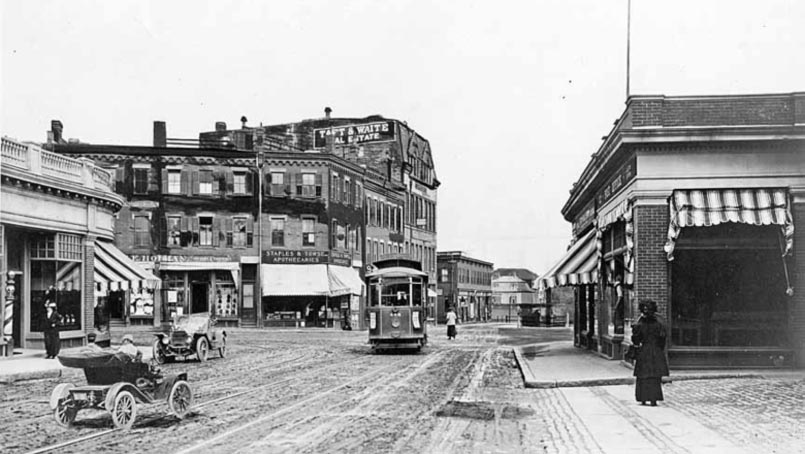
11 Jul Historic Allston Continues to Grow and Change
Historic Boston has been studying the Boston neighborhood of Allston and its historic buildings in order to better understand the neighborhood’s history, buildings and character as it faces dramatic new development. HBI’s Shaurya Batra takes a look at the neighborhood’s evolution over four centuries and the changes it continues to experience.
The Boston neighborhood we know today as Allston has a rich history of its own and one associated with towns and neighborhoods around it. Present day Allston-Brighton and Newton were assigned to the city of Watertown in 1630. The Massachusetts Bay colony transferred ownership of lands along the south side of the Charles River, which included today’s Allston-Brighton and several other towns, to a new entity called Newetowne in 1634, but only four years later, changed the name to Cambridge after the English university and in honor of the “Newe College” (later Harvard). For 160 years the lands that ultimately became Allston-Brighton were part of Cambridge and called “Little Cambridge.”
Before 1775, Little Cambridge was mostly a farming community. The establishment of a cattle market to supply the continental army in 1775 was a key event in the history of the town and a harbinger of the important role cattle would play in the future of Allston and Brighton. Cambridge’s failure to repair the Great Bridge connecting Little Cambridge to Harvard Square and points north, and decisions that threatened the local cattle industry in Little Cambridge led the residents to secede from Cambridge in 1807. Residents chose the name Brighton for the new corporate entity formed as a separate town by legislative approval of the Commonwealth.
The Town of Brighton thrived as a commercial hub, becoming a center of activity in agriculture, cattle and horticulture. Construction of the Boston & Worcester Railroad through the town in 1834 further strengthened the community’s connection to the cattle trade importing cattle from inland states to the Town’s estimated 50 to 60 slaughter houses.
It was the construction of the depot for the Boston and Albany Railroad in 1868 at the eastern edge of the Town of Brighton, and the installation there of an additional post office that led to the creation of a new neighborhood of the town. It was named Allston after Washington Allston, the great 19thcentury artist and poet whose painting,The Fields of West Boston,was said to inspire the Allston name. From the Allston hub at the corner of Cambridge Street and Harvard Avenue, Allston’s earliest civic buildings were built, from the depot we see today (1888), the Allston Fire House (1912), and Allston Hall (1893) at 25 Franklin Street. From this corner, the first streetcar in the region was launched. The 1870’s to 80’s saw groundwork laid for Allston-Brighton’s transformation to a street car suburb. In 1872 all slaughtering activities in the town were consolidated in a single facility, the Brighton Abattoir. This was followed by the moving of the Brighton stockyards to North Brighton. In 1874, the Town of Brighton, along with Allston, was annexed to the City of Boston. Introduction of the electric powered street cars in 1889 further spurred development density in these new “streetcar suburbs.”
By the 1920’ – 30’s an increasing number of motor vehicles combined with the flight of many long term residents to the outer suburbs led to a period of high density development in Allston and Brighton. Many one or two story multi-store commercial blocks that we see today were built around the 1910-20’s. The spurt in development brought new businesses to the area, especially the burgeoning automobile sales industry. The portion of Commonwealth Avenue from Brighton Avenue toward Kenmore Square in Allston became Boston’s first “automile” and was home to a concentration of automobile showrooms, automobile services, auto supply shops and gas stations. The demographics shifted to working and middle class immigrants from the old Allston families in this period of time. By 1950, the combined population of Allston-Brighton was 70,000.
Through the 1960-70’s, Allston became a hub for newer immigrants and student populations. Owning to the presence of a youthful population and the numerous bars and concert venues in Allston, the neighborhood took on the moniker “Allston Rock City”. Rock band Aerosmith lived in an apartment at 1325 Commonwealth Avenue in their formative years where they purportedly recorded the hit song “Dream On,” and Baby Boomers may remember Allston’s unique zip-code “02134” as a popular ditty on the PBS television show Zoom in the 1970s, a program produced in Allston at WGBH.

Today, Allston is a vibrant part of the city with a strong connection with its history through its built fabric. At the center is Allston Village, home to historic assets like the Allston Hall, Allston Depot, Allen building, Longfellow Block, Chester Block, and the Harvard Avenue Fire Station.
But it is Allston’s proximity to educational institutions in Boston and Cambridge, access to the green line, a burgeoning music and restaurant landscape, and relatively economical rental housing that is attracting a new generation of development to the neighborhood. Within a 1.5 square mile radius of Allston Village are over 1400 residential units proposed, currently at various stages of development. These range from large developments like Boston Landing and Allston Yards to smaller stand-alone five to nine unit multi-family.
Development activity is clearly a good sign for the neighborhood and a city with high need and demand for housing. Allston-Brighton is a gritty neighborhood with a diverse population and a strong historical connection. However, given the market forces at play, there is a strong need to safeguard the historical resources in the face of this transformational wave of construction, and preserve the character of Allston’s rich history in which everyone can take pride.



